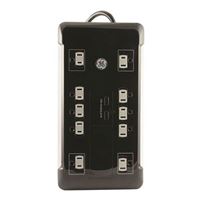Defend Your Electronics with Surge Protectors
If you are reading this, you probably have expensive electronic devices like laptop and desktop computers, home theater equipment, game consoles, or charging smartphones plugged into your wall outlets - and that means surge protectors are a must have. Almost every electrical system will experience a transient voltage - a power surge or voltage spike - at some point, and the causes can be anything from a lightning strike to overloaded wiring. When that happens, a surge protector will help keep your devices and power cables safe from potentially devastating damage.
Surge protectors plug into wall outlets, and they typically also function as power strips or plug in taps by providing extra power outlets. Thus, in addition to protection against power surges, these outlet surge protectors provide a charging station and a place to plug in all of your speakers, chargers, televisions, and other devices. Remember, however, that not all power strips are surge protectors. Moreover, to ensure that your surge protector power strip meets your needs, it is important to check the factors we will talk about below.
Choosing the Best Surge Protector for You
These are some of the most relevant factors in choosing the best surge protector:
Form Factor: Surge protectors come in several form factors, including the classic power strip and the low footprint wall tap design. Each type comes in a variety of sizes and varying numbers of outlets, so consider which will fit best in your space and offer the right features.
Joule Rating: Every surge protector is rated to withstand a certain number of joules - a measurement of electrical voltage - in its lifetime. Higher joule ratings offer longer lifespans and more protection for valuable electronics. Most surge protectors also include an indicator light that will shut off when it has exceeded its lifetime joule rating.
Maximum Surge Voltage: Most surge protectors are rated for a maximum number of volts they can absorb from a single power surge. A lower maximum voltage may be sufficient for home office surge protectors, while units used in heavy duty commercial applications may require a higher rating.
Cord Length: Your surge protector can also function as an extension cord. Just look for a model with a long power cord that is suitable for your space.
UL Testing: Surge protectors that feature UL ratings have been tested by the independent safety testing organization Underwriters Laboratories. UL testing is important for verifying that a particular model offers the performance you need and that it is rated to stand up to particular conditions.
USB Ports: Many surge protectors now include USB charging ports for convenient charging of your smartphone, smart watch, or other USB devices.
Connected Equipment Warranty: Surge protector manufacturers often offer a warranty on equipment connected to the surge protector if the protector fails to do its job. Be sure to check the conditions of the equipment warranty, since each manufacturer sets its own standards.
Micro Center is a one stop destination for all kinds of surge protection solutions, so shop our full lineup here and find great prices. For more options to keep your electronics safe, be sure to see our uninterruptible power supplies as well.


